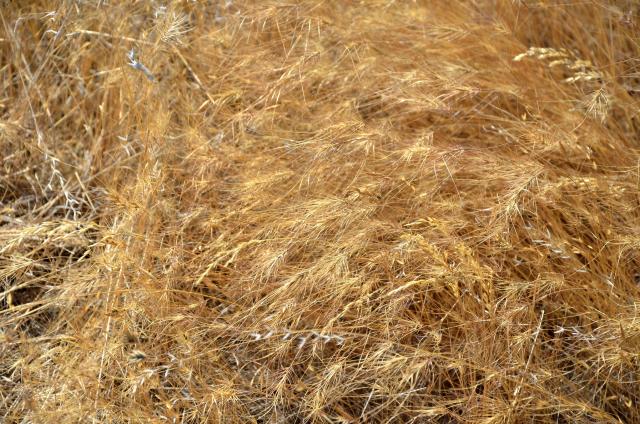You are viewing ARCHIVED content published online before January 20, 2025. Please note that this content is NOT UPDATED, and links may not work. Additionally, any previously issued diversity, equity, inclusion or gender-related guidance on this webpage should be considered rescinded. For current information, visit https://www.blm.gov/blog.
Invasive Species and BLM Fire
It’s no secret that in our modern, global society, organisms from all over the world have been introduced into ecosystems where they are not naturally found, sometimes with serious consequences for those ecosystems. In the worst cases, these non-native plants, animals, pathogens, or microorganisms have traits that allow them to proliferate and outcompete native species. These are called invasive species, and they can cause severe, lasting damage to public lands.
Invasive species have special relevance in the context of wildland fire. Each year, both naturally-occurring and human-caused wildfires affect ecosystems nationwide, including the sagebrush ecosystem, of which the BLM stewards millions of acres. Fire-prone invasive species, especially invasive annual grasses, in these areas are contributing to uncharacteristic fire behavior, causing large and pervasive problems across the western United States. These grasses grow and spread rapidly, providing more continuous fine fuels that can carry fire over large areas and can do so frequently. Meanwhile, native species, which are not adapted to this intensity and frequency of fire, are destroyed on large scales, which leaves the landscape all the more vulnerable to further invasion.
Meet a few of the worst offenders below.
Cheatgrass (Bromus tectorum)
If you’ve only heard of one invasive species, there’s a good chance that it is cheatgrass. Native to Europe and parts of Africa and Asia, this grass is contributing to large, destructive wildfires across many areas of the country, including the Great Basin.
Areas that have been invaded by cheatgrass are roughly twice as likely to burn. As the name implies, cheatgrass “cheats” native vegetation by greening up early in the growing season, using up the limited moisture and nutrients available on arid rangelands. Then, it dries out early in the summer, leaving broad swaths of highly flammable fuel during the hottest months of the year. Cheatgrass also grows densely across large areas, in contrast to patchier native vegetation which naturally resists rapid fire spread. The result is a vicious cycle in which cheatgrass promotes more wildfire, and those wildfires promote more cheatgrass.


Medusahead (Taeniatherum caput-medusae)
Medusahead is an invasive grass that thrives in rangeland habitats, with a “head of snakes” consisting of many barbed awns that readily hitchhike on people and other animals. Furthermore, it creates a dense litter layer that prevents the germination of native species. It is very flammable and increases the chances of large, catastrophic wildfires. It is native to the Mediterranean region of Europe.


Ventenata (Ventenata dubia)
Introduced from North Africa, this grass invades both non-forested areas like shrublands and mixed conifer forests, including some ecological communities that had not previously seen significant impacts from other annual invasive grasses. Despite being a poor forage crop, ventenata frequently invades managed grass-hay systems. Like its fellow invasive grasses, it promotes unnaturally frequent and large wildfires, contributing to a feedback loop that disproportionately affects native species.


Protecting public lands from further encroachment of invasive species is a big challenge, but there are simple ways for us all to help!
- Clean your shoes, clothes, packs, and pets before and after exploring, and stay on designated trails.
- Clean your horses’ hooves and feed them weed-free certified hay before your adventure.
- Clean, drain, and dry your watercraft and angling equipment to stop aquatic hitchhikers.
- Don’t move firewood. Buy it where you burn it, buy certified heat-treated firewood, or gather on site when permitted.
- Before traveling to new areas, inspect and clean your trailers, off-road vehicles, and recreational vehicles with water or compressed air to remove mud, plant parts, and hidden pests.
- Do a little homework. Find out about invasives that affect your local area or areas where you plan to recreate and what mitigations local land managers recommend.
Ready for a deeper dive?
- Michele Crist, BLM Fire Landscape Ecologist, recently released a study on the increase of wildfires on non-forested lands due to invasive species. You can also listen to her being interviewed on the Wildfire Matters podcast!
- The BLM is conducting a major project called Restoration for Resilience, utilizing funding from the Bipartisan Infrastructure Law and the Inflation Reduction Act to protect and repair 21 valuable and vulnerable landscapes across the western United States from threats such as the encroachment of invasive species.
- The BLM is partnering with the Intermountain West Joint Venture (IWJV) to address threats and opportunities in sagebrush ecosystems and Restoration Landscapes, including reducing wildfire risk and preventing and controlling noxious and invasive weeds.
This story is part of the “Unleashing the Science” series, showcasing how bureaus within the Department of the Interior produce and apply science to ensure responsible management decisions for our planet now and for the future.

This story is part of the “Unleashing the Science” series, showcasing how bureaus within the Department of the Interior produce and apply science to ensure responsible management decisions for our planet now and for the future.
Rebecca Paterson, Public Affairs Specialist
Related Stories
- BLM Fire Team brings Smokey Bear to Kingman’s Street of Lights
- Rural wildland firefighting partners grateful for BLM gift
- BLM hosts fire investigation training course to strengthen wildland fire investigation capacity across Arizona and the West
- Helping Woodlands & Fighting Fire with the Dawson Project
- BLM delivers on administration priorities
